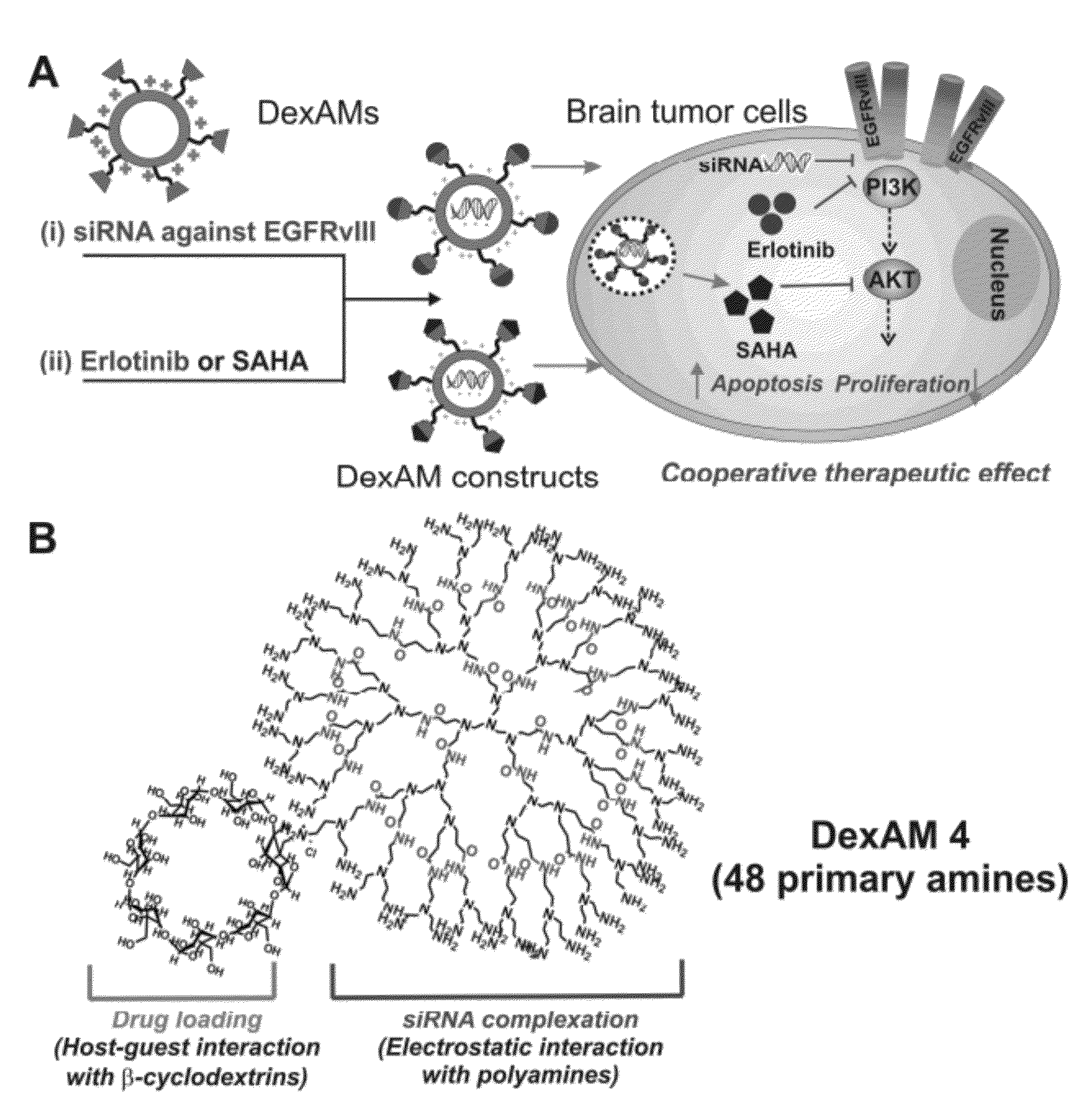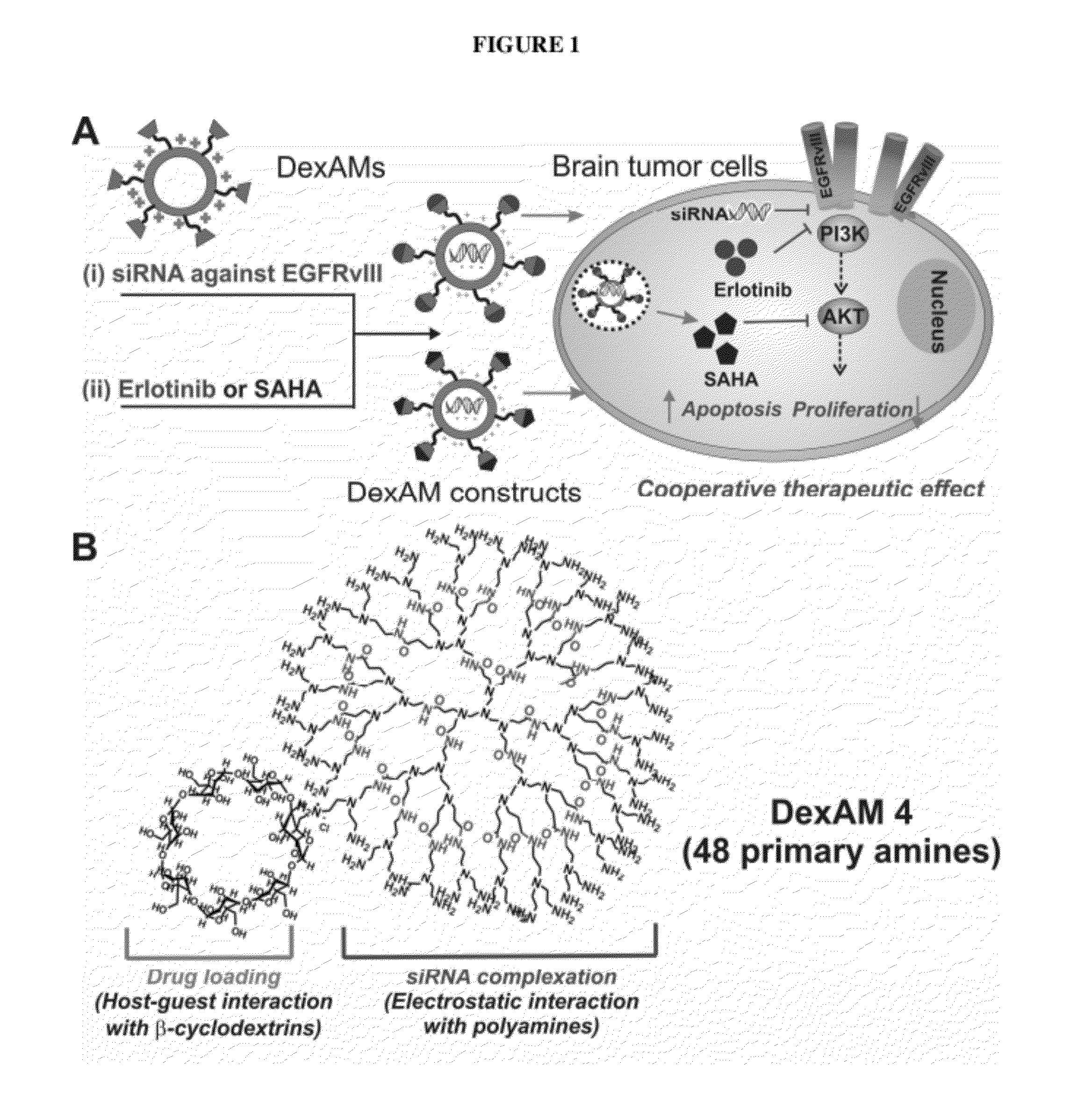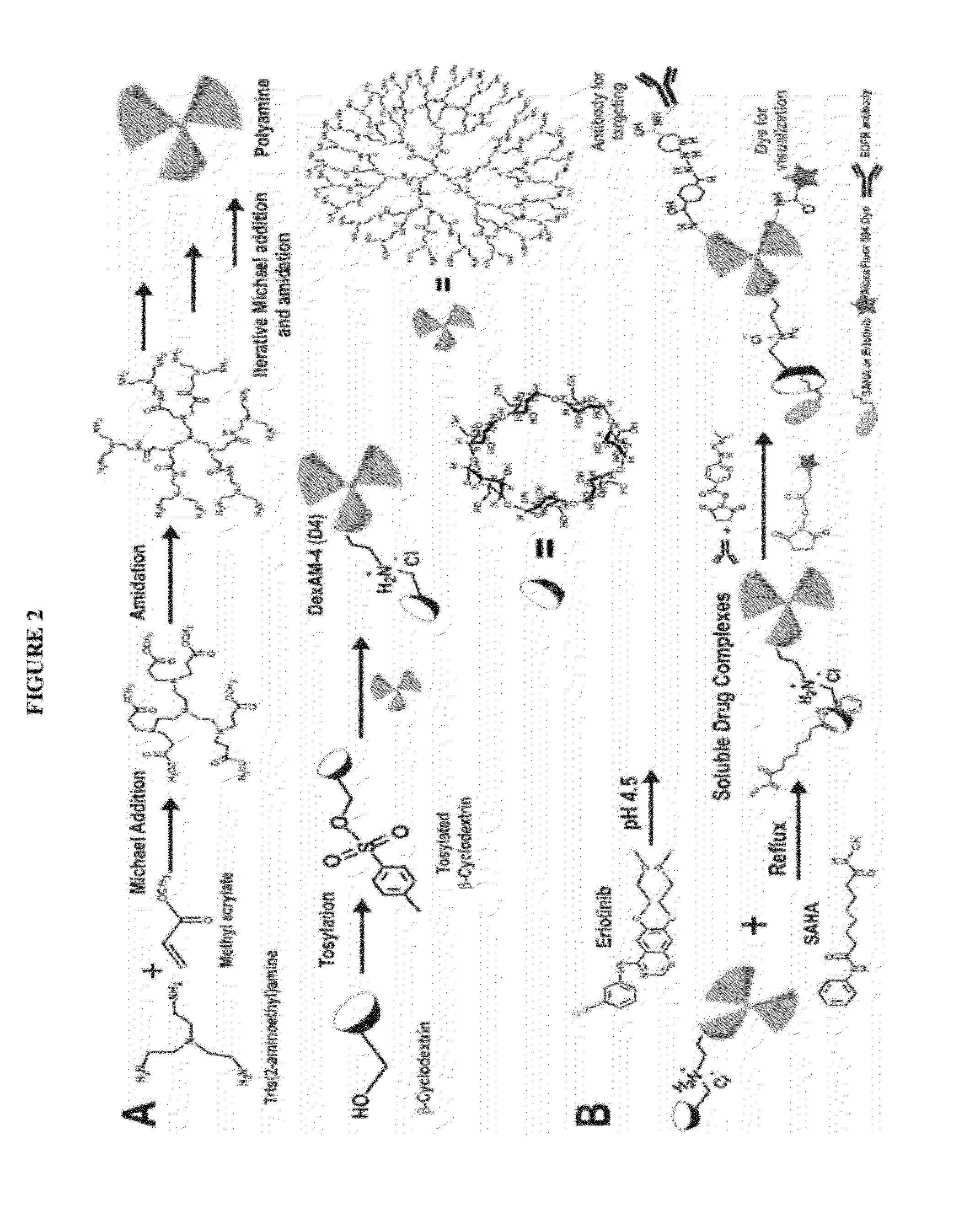Cyclodextrin-modified polyamines for delivery of therapeutic molecules
a technology of cyclodextrin and polyamine, which is applied in the field of chemical genetics and molecular cell biology, can solve the problems of delayed downstream effects of gene-silencing and poor cellular uptake, and achieve the effect of efficient nucleic acid translocation
- Summary
- Abstract
- Description
- Claims
- Application Information
AI Technical Summary
Benefits of technology
Problems solved by technology
Method used
Image
Examples
example 1
Materials and Methods
[0050]β-cyclodextrin, tosylimidazole, di-tert-butyl dicarbonate, tris(aminoethyl)amine, methyl acrylate, 6,7-dimethoxyquinazolone, aniline, amberlite IRA 900 were obtained from Sigma-Aldrich and used as received unless otherwise noted. 6-hydrazinonicotinamide and 4-formylbenzamide were from SoluLinK. Other chemicals and solvents were of analytical reagent grade. All reactions were conducted in flame-dried glassware with magnetic stifling under an atmosphere of dry nitrogen. Reaction progress was monitored by analytical thin layer chromatography (TLC) using 250 μm silica gel plates (Dynamic Absorbents F-254). Visualization was accomplished with UV light and potassium permanganate stain, followed by heating. Proton nuclear magnetic resonance (1H NMR) spectra were recorded on either a Varian-300 instrument (300 MHz), Varian-400 instrument (400 MHz) or a Varian-500 instrument (500 MHz). Chemical shifts of the compounds are reported in ppm relative to tetramethylsila...
example 2
Synthesis of DexAM 1
[0065]The scheme for the synthesis of DexAM 1 is depicted in FIG. 3.
1.1 Synthesis of Mono-Tosylated Cyclodextrin (2)
[0066]β-cyclodextrin (8.75 g, 7.71 mmol) and tosylimidazole (2.22 g, 10.0 mmol) was dissolved in 88 ml deionized water. The solution was vigorously stirred for 4 h at room temperature. Aqueous NaOH solution (1% (w / v), 10.0 ml) was gradually added to the solution and stirred for an additional 10 min. The insoluble solid was filtered off and the filtrate was collected. The filtrate was neutralized to pH 7 using NH4Cl to induce precipitation. The precipitate was then collected by filtration, washed with cold water (25 ml 3) and with acetone (25 ml 4). The solid was dried in a drying oven at 60° C. under vacuum (10 mm Hg) overnight to yield 2 as a white solid (4.5 g, 51% yield). 1H NMR (300 MHz, DMSO-d6), δ 7.72 (d, J=8.4 Hz, 2H), 7.41 (d, J=8.4 Hz, 2H), 5.60-5.89 (m, 14H), 4.75-4.81 (m, 7H), 4.15-4.62 (m, 6H), 3.45-3.72 (m, 28H), 3.15-3.47 (m, 24H), 2....
example 3
Synthesis of DexAM 2
[0077]The scheme for the synthesis of DexAM 2 is depicted in FIG. 4.
2.1 Bis-[2-(tert-butoxycarbonylamino)ethyl]-(2-aminoethyl)amine (16)
[0078]Tris(2-aminoethyl)amine (7, 14.6 g, 100 mmol) was dissolved in 40 mL of dry CH2Cl2 and cooled to 0° C. A solution of di-tert-butyl dicarbonate (44.11 mL, 200 mmol) in 50 mL dry CH2Cl2 was added dropwise over 1 h. The mixture was stirred at room temperature for 24 h. After removal of the solvent under reduced pressure, the remaining yellow oil was dissolved in ethyl acetate and washed twice with 0.5 N NaOH. The aqueous phase was diluted with brine and re-extracted with ethyl acetate. The combined organic phases were dried over MgSO4 and the solvent removed under reduced pressure. The crude products were purified by flash chromatography on SiO2. The fractions containing the desired product were identified by TLC and characterized by mass spectroscopy and NMR. The product (16) was isolated as a pale-yellow oil. Yield: (18.02 g...
PUM
| Property | Measurement | Unit |
|---|---|---|
| Therapeutic | aaaaa | aaaaa |
| Chemotherapeutic properties | aaaaa | aaaaa |
Abstract
Description
Claims
Application Information
 Login to View More
Login to View More - R&D
- Intellectual Property
- Life Sciences
- Materials
- Tech Scout
- Unparalleled Data Quality
- Higher Quality Content
- 60% Fewer Hallucinations
Browse by: Latest US Patents, China's latest patents, Technical Efficacy Thesaurus, Application Domain, Technology Topic, Popular Technical Reports.
© 2025 PatSnap. All rights reserved.Legal|Privacy policy|Modern Slavery Act Transparency Statement|Sitemap|About US| Contact US: help@patsnap.com



